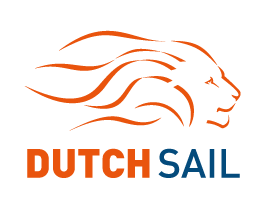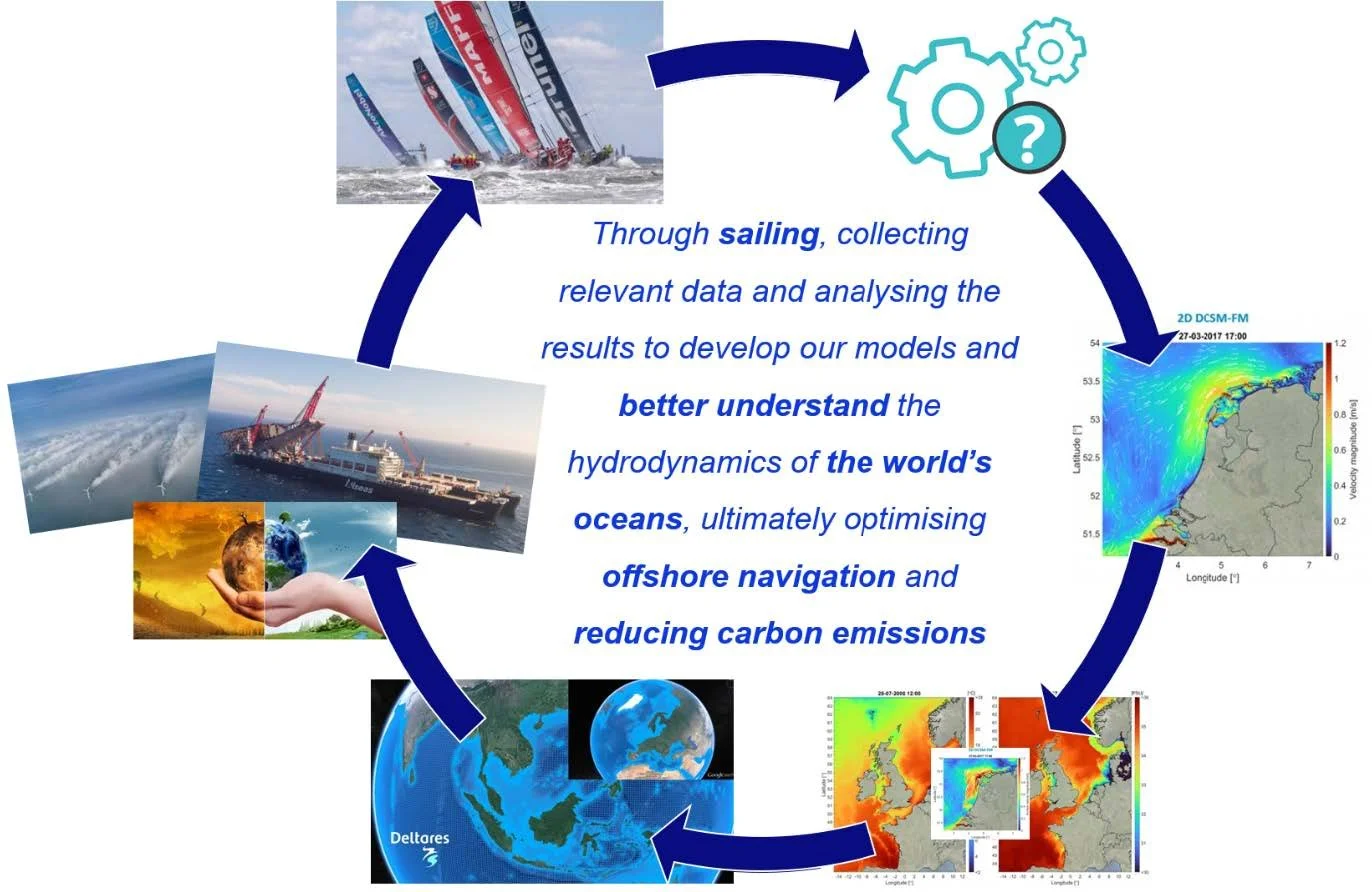Evaluation of the TKI Ocean Race research project
This project is conducted in the period 2022 – 2024 under the TKI Maritime program: Top consortium Knowledge & Innovation (in Dutch: Topconsortia voor Kennis en Innovatie), a program supported by Ministry of Economic Affairs, represented by RVO (Rijksdienst voor Ondernemend Nederland) and Topsector Water & Maritime.
The project worked together with the following consortium partners:
DutchSail B.V. (referred to as DutchSail. Representing Team JAJO)
Stichting Deltares (referred to as Deltares)
Allseas Engineering B.V. (referred to as Allseas)
Poortman Sailing Services/Rotterdam Offshore Sailing Team (referred to as ROST)
Stichting New-York – Rotterdam (referred to as NYR rowing team)
Provincie Zuid-Holland
The project objective is: Through sailing, collecting relevant data and analysing the results to develop our models and better understand the hydrodynamics of the world’s oceans, ultimately optimising offshore navigation and reducing carbon emissions.
The hydrodynamic models used under this project are described in the final report and in chapter four the operational framework for making forecasts using these hydrodynamic models. Next, chapter five elaborates on the sailing competitions and concludes with a validation of the delivered forecasts with the measurements from the field campaigns. Chapter six elaborates on the pilot carried out with Allseas with a heavy lift operation in the East Irish Sea. Chapter seven describes the last field campaign executed under this research project, a trans-Atlantic rowing challenge. Highlights from the Ocean Summit in The Hague are discussed in chapter eight.
During the 2022-23 edition of the Ocean Race, a scientific program is carried out to collect relevant data, evaluate the performance of flow predictions and analyse measurements, to ultimately optimise offshore navigation and reduce carbon emissions.
The following field campaigns are carried out by the consortium partners:
i) The European Championships for Sailing in Breskens, participated by ROST
ii) The Ocean Race 2022-23, participated by Team JAJO
iii) The Fastnet Race, participated by ROST and Team JAJO
iv) An offshore heavy lift operation called ‘project Morecambe’, executed by Allseas
v) A trans-Atlantic rowing challenge, executed by the NYR rowing team.
Measurements and relevant field experiences acquired under these field campaigns have enhanced our understanding of the hydrodynamics at several locations of the world’s seas and oceans. However, obtaining highly accurate current data from a sailing boat, especially in high seas, is hard. Nonetheless, an assessment of model accuracy has been conducted based on a data-model-comparison and experiences from the crew.
Based on the assessment, it is concluded that the forecasted ocean current provided by Deltares generally align well with the observed ocean currents, a finding supported by the pilot carried out with Allseas and the Trans-Atlantic rowing challenge.
Based on the experience of the sailors, the forecasts can be improved by:
Including wave effects as a measure of the sea state. Often underestimated, but important for sailors and the offshore industry, is the effect of waves on offshore vessels. For the offshore industry, under specific circumstances and depending on the type of vessel and its crew, resonance-like-behaviour can occur which affects transits and offshore operations, both in terms of conveniences and efficiency. Sailors take waves into account as a safety concern in their routing. Especially for the foiling IMOCA’s in the next ocean race, accurate information on wave conditions will be crucial as these boats are much more sensitive to the sea state than the older generation VO65 boats.
Offering higher time-resolution in hydrodynamic forecasts. Accurate information on timing of the slack water moments significantly improves offshore operations, in termsof competition, workability and efficiency (reducing carbon emissions).
Improving surface current estimates by moving to a 3D model approach. Ocean currents are generally underestimated with depth average models.
During field campaigns, other ocean parameters like sea surface temperature and salinity are good indicators to assess the reliability of the overall model performance. Adding these 3D ocean parameters to the forecasts and being able to compare them to site conditions, helps to optimize offshore navigation and reduce emissions.
Allow generation of even higher resolution, nested models for areas with complex geometries and local features such as the British south coast and the Baltic Sea.
Keep coupling science with sports. Innovative measurement techniques to obtain accurate and reliable ocean measurements, benefit sport teams during trainings and competitions for optimizing their performances and enables Deltares to validate their models.
ALLSEAS, Morecambe Bay project
As part of the TKI Ocean Race and Oceans Sustainability research project, Deltares carried out a pilot with Allseas for an offshore operation in the Morecambe Bay, Irish Sea.. It was tested whether Deltares ocean forecasts can have an added value for this offshore operation carried out by Allseas, for planning and executing a safe and efficient (in terms of CO2-emmisions) operation.
The tidal range in the Morecambe Bay is approximately 9 meters, which induces strong tidal currents.
The Morecambe project took place in July 2023, when the Pioneering Spirit removed 2 Jackets in just two days. The 4,500-tonnes structure was transferred offshore to the cargo barge Iron Lady (Figure), for transfer to the recycling yard.
The numerical model that is used to simulate the tidal and wind-induced currents is named 2D DCSM-FM. At locations DP3 (53.815850° N, 3.561767° W) and DP4 (53.875261° N, 3.561011° W), the resolution is approximately 1 nautical mile. These locations, together with the computational grid and tide gauges stations in the Morecambe Bay area, are used.
Figure: Allseas Morecambe project. The Pioneering Spirit lifting the second offshore jacket with Iron Lady moored next to it. Operations are timed favourably (during slack water) by means of the TKI Ocean Race Pilot.
Team JAJO in the OCEAN RACE
Feedback navigator Team JAJO: “The models from Deltares helped us very well in the Strait of Gibraltar. There we gained many miles compared to the competitors by staying close to the coast (less head current). Furthermore, we also experienced less current at the entrance and exit of the street by staying north of the stronger current.
We benefited from the models during the legs, especially around Gibraltar and in the UK Channel. Our speedometer had some problems, so the measurement data may not be reliable. Nevertheless, we noticed that the Deltares models accurately predicted the ocean currents both in time and space. We used both the Deltares model and the TideTech model such that we could compare and get a feel for uncertainties.”
Figure: Team JAJO at the finish in Genova
ROST
With the help of a flow model from Deltares and clever sailing, ROST managed to achieve 2nd place during the European Sea Sailing Championship on the Western Scheldt near Breskens. Besides the young talent in the boat and good coaching of the sailing team, a decisive asset was knowledge about the currents in the dynamic area in the estuary of the Western Scheldt.
The Western Scheldt is a very challenging sailing area with its tidal currents, sandbanks, and deep shipping channels. To make strategic choices based on the prevailing currents, an accurate numerical model can be used, which includes the weather patterns that affect the local currents. Deltares provided a new forecast every 6 hours, based on the latest meteorological forecast, of the flow velocities in the Western Scheldt. According to ROST the quality of the data was accurate enough to make tactical choices and seek for the fastest route. Thorough preparation is ‘key’ within the sport and the collaboration with Deltares made this possible. Feedback coach ROST: “The result was astonishing. A second position during the
https://www.deltares.nl/en/news/rost-takes-silver-at-european-sea-sailing-championship-with-help-from-deltares/
ROST competing during the European Sea Sailing Championship on the Western Scheldt near Breskens
Team JAJO in the FASTNET Race
In July 2023 both Team JAJO and ROST participated in the Fastnet Race. This is an offshore yacht race which takes place every two year between Cowes (South of the UK) and Cherbourg (France) rounding the iconic Fastnet Rock (South of Ireland). An epic race of 700 nm. This edition, heavy weather made it tough competition, which caused ROST to retire after approximately 8 hours of sailing due to structural damage the boat sustained. Team JAJO finished in 2nd place. Deltares shared their 2D DCSM-FM product with both teams.
Feedback navigator Team JAJO: “During the iconic Rolex Fastnet Race there are several important land points where currents have a major effect. The more than 350 teams participating all try to capture the most favourable currents. The VO65 Team JAJO received flow data from Deltares and thus received very detailed information that made a significant contribution to achieving a 2nd place in the general classification.”
“For us, the ocean current was mainly important for the section between Southampton and Lands End. This is where the landscape has many features that influence ocean current. The biggest difference between the data provided by Deltares compared to the commercial data that we obtained, was that the Deltares ocean current seemed to be much more accurate around these different landscape features. We try and aim for most favourable currents, even if that means differences of 0.1nm. This determines how close we sail to the coast, aiming for favourable currents near specific landscape features. Here we saw that the difference between the current at sea vs. close to the coast in the Deltares model is much larger, and in reality more precise, than in commercial models. This gave us an advantage over the other teams.”
PROVINCE of South Holland
The TKI Ocean Race project, including several field campaigns, has highlighted the potential for enhanced oceanic understanding to significantly benefit the maritime industry.
Improved understanding of ocean hydrodynamics not only cuts cost and time, but also enhances sea safety and reduces CO2 and other emissions. This also reduces emissions in the coastal areas os the Province of South Holland.





